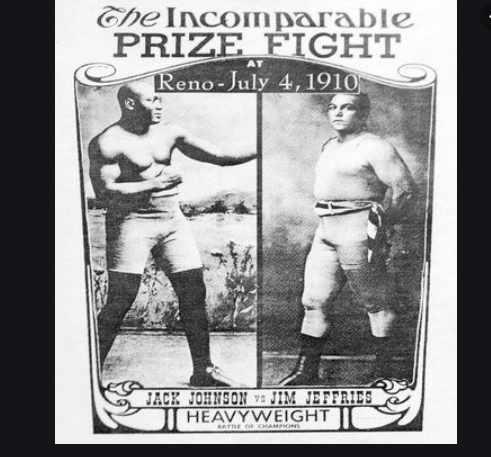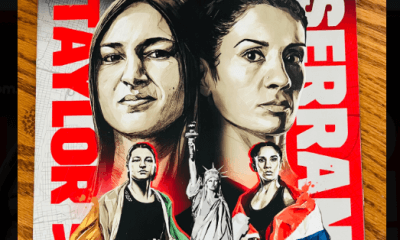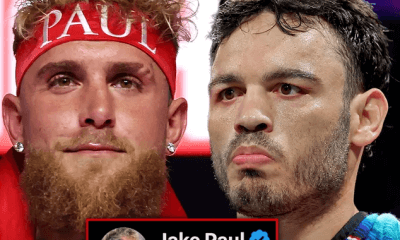Featured Articles
Nevada Boxing Hall of Fame Honoring Hopkins, Goossen, Chacon and Others

Nevada Boxing Hall of Fame Honoring Hopkins, Goossen, Chacon and Others
When people think of Nevada they mostly envision Las Vegas. But the elongated “Silver State” stretches nearly as far in length as its “Golden State” neighbor California.
Nevada also possesses as many riches in the sport of boxing going all the way back to 1897 when Bob Fitzsimmons wrested the heavyweight title from Jim Corbett in Carson City and including the famous fight in Reno in July of 1910 when the great Jack Johnson faced off against Jim Jeffries.
Since that epic battle that saw Johnson win by knockout, many other historic prize fights emblazoned the boxing rings from Reno to Las Vegas for more than a century. Nevada has a very rich prizefighting history.
More than a dozen prizefighters, judges and boxing notables will be honored and celebrated at the Seventh Annual Induction Ceremony by the Nevada Boxing Hall of Fame. All of the two-day events take place at the Red Rock Resort and Casino in Las Vegas beginning Friday, Aug. 9.
In alphabetical order, here are the fighters being inducted:
Joel Casamayor – the Cuban southpaw known as “El Cepillo,” or the “the Brush,” arrived in the US with a more aggressive style than most of his fellow Cubans. Fearless and determined, his battles with Acelino Freitas, Diego Corrales and Juan Manuel Marquez are among the fiercest and bloodiest fights ever seen. Anyone who ever saw Casamayor in the boxing ring knew it would be memorable. He now resides in Las Vegas and is a trainer.
Bobby Chacon – the native Los Angeles prizefighter known as “Schoolboy” passed away several years ago in 2016. He engaged in only a few battles in Nevada, but they were unforgettable. After participating in the Fight of the Year in 1982, Chacon then fought Cornelius Boza-Edwards in Las Vegas at Caesars Palace in the 1983 Fight of the Year. Few could match the pure guts and determination of the super featherweight Chacon. He was also one of the most beloved fighters the sport has ever known.
Humberto Gonzalez – the diminutive light flyweight from Mexico City known as “Chiquita” was part of a generation that propelled the little guys to million dollar fights. His battles with Arizona’s Michael Carbajal – especially their first encounter at the Hilton Hotel in Las Vegas in 1993 – were historic in bringing American attention to the light flyweight division. Chiquita is now a promoter.
Leroy Haley – the super lightweight was born in Arkansas but Las Vegas became a permanent base of operations for the fighter known as “Irish” Leroy Haley. Many of his fights took place at the old Silver Slipper in Las Vegas and were televised. For a while he fought almost weekly in the year 1973. He was an important cog in making Las Vegas a fight town. He captured the world title against the ultra-slick Saoul Mamby in 1982 and also won the rematch. Haley retired in 1985 and still lives in Las Vegas.
Bernard Hopkins – is one of the best middleweights to ever lace up the gloves. The Philadelphia fighter was one of the most scientific and disciplined boxers the sport has ever known. He proved it in his epic showdown against Puerto Rico’s Felix Trinidad then went on to the light heavyweight division and won a world title in the heavier weight class too while in his 40s. One of boxing’s most amazing athletes he fought many of the best such as Oscar De La Hoya and Joe Calzaghe. Now both Hopkins and De La Hoya are part of the same boxing company Golden Boy Promotions.
Juan Manuel Marquez – the Mexico City prizefighter remains one of his country’s most under-rated fighters of all time. Perhaps because his style was very scientific and precise, he is not appreciated as one of Mexico’s finest prizefighters. Who can forget his four intense battles against Manny Pacquiao that all took place in mega fights held in Las Vegas? Marquez won world titles in the featherweight, super featherweight, and lightweight divisions.
Wayne McCullough – the “Pocket Rocket” from Belfast, Ireland was always a crowd favorite with his high intensity prizefighting style. He captured the bantamweight world title in Japan but later made Las Vegas his home base. He fought a number of world title bouts in Nevada including his final world title challenge against Oscar Larios in 2005. McCullough is also a very beloved fighter outside of the ring and was recently training boxers in Southern California.
Terry Norris – the super welterweight was one of Abel Sanchez’s earliest champions and was known for his speed and electric power. Known as “Terrible” Terry Norris, the San Diego-based prizefighter could end a fight with a single punch and often did. He defeated a number of big punchers and champions such as John “the Beast” Mugabi, Sugar Ray Leonard, Donald Curry, and Simon Brown. He was always worth watching because knockouts were his specialty. But if he needed to box he was fully capable of providing that too.
Vinny Pazienza – the Rhode Island prizefighter has one of the more incredible stories in a sport filled with incredible stories. Paz won world titles as a lightweight and a super welterweight and fought as heavy as a light heavyweight and won. In 1991 he was involved in a serious car accident and suffered a broken neck. It was thought his career was over but Paz returned 13 months later and continued fighting. Among those Paz fought are Greg Haugen, Hector Camacho, Roy Jones Jr. and Roberto Duran. He had one incredible boxing career.
Hasim Rahman – the heavyweight champion shocked the boxing world when he knocked out Lennox Lewis in the fifth round in South Africa. Though he lost the rematch seven months later, Rahman proved to be an always dangerous heavyweight in a career that began in 1994 and ended in 2014. Among those he battled were David Tua, Trevor Berbick, Corrie Sanders and James Toney. Known as “the Rock” he was in the heavyweight mix throughout his career.
Winky Wright – the Florida native never was flashy, powerful or speedy, but whoever he fought he brought trouble with a capital T. From super welterweight to super middleweight Wright brought his close guard style against some of the fiercest fighters and defused their power. Among those he fought were Fernando Vargas, Shane Mosley, Ike Quartey, Bernard Hopkins and Felix Trinidad. After dominating the Puerto Rican legend Trinidad retired a week later. Wright was always a tough nut to crack.
Non-Fighters
Dan Goossen – the Southern California-based promoter loved the sport of boxing and brought many of the best fights in history to both his native state and to Nevada. Goossen passed away in September 2014 and was beloved by all those who knew him. One of his proudest moments was staging James Toney’s upset knockout win over heavyweight legend Evander Holyfield in 2003. He also launched the careers of Andre Ward, Chris Arreola and Paul Williams.
Duane Ford – judged over 600 fights in Nevada and worldwide including Japan, Poland, Mexico, Germany, Panama and Thailand. Among those he oversaw in the prize ring were Wilfredo Gomez, Larry Holmes, Oscar De La Hoya, Mike Tyson and Sugar Ray Leonard.
Dr. Edwin “Flip” Homansky – was a ringside physician for thousands of bouts including the Mike Tyson-Evander Holyfield battle in 1997. He also inspected fighters such as Muhammad Ali, Julio Cesar Chavez, Tommy Hearns, Felix Trinidad and thousands of others.
Floyd Mayweather Sr. – the father of Floyd Mayweather Jr. has long been a distinguished teacher of prizefighting beginning with his own son and including other future Boxing Hall of Fame fighters such as Oscar De La Hoya. His knowledge of the sweet science has been long sought by many and he continues to be a strong influence in the sport.
Marc Risman – the Las Vegas-based attorney represented Grammy and Emmy winners along with Olympians and boxing stars in his lengthy career. He also represented Don King and Julio Cesar Chavez and has long been a fan of the sport.
Check out more boxing news on video at The Boxing Channel
To comment on this story in The Fight Forum CLICK HERE
-

 Featured Articles4 weeks ago
Featured Articles4 weeks agoAvila Perspective, Chap. 330: Matchroom in New York plus the Latest on Canelo-Crawford
-

 Featured Articles3 weeks ago
Featured Articles3 weeks agoVito Mielnicki Jr Whitewashes Kamil Gardzielik Before the Home Folks in Newark
-

 Featured Articles17 hours ago
Featured Articles17 hours agoResults and Recaps from New York Where Taylor Edged Serrano Once Again
-

 Featured Articles4 weeks ago
Featured Articles4 weeks agoCatching Up with Clay Moyle Who Talks About His Massive Collection of Boxing Books
-

 Featured Articles5 days ago
Featured Articles5 days agoFrom a Sympathetic Figure to a Pariah: The Travails of Julio Cesar Chavez Jr
-

 Featured Articles3 weeks ago
Featured Articles3 weeks agoMore Medals for Hawaii’s Patricio Family at the USA Boxing Summer Festival
-

 Featured Articles7 days ago
Featured Articles7 days agoCatterall vs Eubank Ends Prematurely; Catterall Wins a Technical Decision
-

 Featured Articles4 weeks ago
Featured Articles4 weeks agoRichardson Hitchins Batters and Stops George Kambosos at Madison Square Garden




















